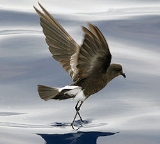
Storm-petrel
Overview
Storm petrels are seabird
s in the family
Hydrobatidae, part of the order Procellariiformes
. These smallest of seabirds feed on plankton
ic crustaceans and small fish picked from the surface, typically while hovering. The flight is fluttering and sometimes bat
-like.
Storm petrels have a cosmopolitan distribution
, being found in all oceans. They are strictly pelagic, coming to land only when breeding. In the case of most species, little is known of their behaviour and distribution at sea, where they can be hard to find and harder to identify.
Seabird
Seabirds are birds that have adapted to life within the marine environment. While seabirds vary greatly in lifestyle, behaviour and physiology, they often exhibit striking convergent evolution, as the same environmental problems and feeding niches have resulted in similar adaptations...
s in the family
Family (biology)
In biological classification, family is* a taxonomic rank. Other well-known ranks are life, domain, kingdom, phylum, class, order, genus, and species, with family fitting between order and genus. As for the other well-known ranks, there is the option of an immediately lower rank, indicated by the...
Hydrobatidae, part of the order Procellariiformes
Procellariiformes
Procellariiformes is an order of seabirds that comprises four families: the albatrosses, petrels and shearwaters, storm petrels, and diving petrels...
. These smallest of seabirds feed on plankton
Plankton
Plankton are any drifting organisms that inhabit the pelagic zone of oceans, seas, or bodies of fresh water. That is, plankton are defined by their ecological niche rather than phylogenetic or taxonomic classification...
ic crustaceans and small fish picked from the surface, typically while hovering. The flight is fluttering and sometimes bat
Bat
Bats are mammals of the order Chiroptera "hand" and pteron "wing") whose forelimbs form webbed wings, making them the only mammals naturally capable of true and sustained flight. By contrast, other mammals said to fly, such as flying squirrels, gliding possums, and colugos, glide rather than fly,...
-like.
Storm petrels have a cosmopolitan distribution
Cosmopolitan distribution
In biogeography, a taxon is said to have a cosmopolitan distribution if its range extends across all or most of the world in appropriate habitats. For instance, the killer whale has a cosmopolitan distribution, extending over most of the world's oceans. Other examples include humans, the lichen...
, being found in all oceans. They are strictly pelagic, coming to land only when breeding. In the case of most species, little is known of their behaviour and distribution at sea, where they can be hard to find and harder to identify.
Unanswered Questions

